Cavehill and Whitewell Tramway
History
This tramway, which served a small number of settlements to the north of Belfast, rather bucked the usual evolutionary trend, starting off with steam traction, which it gradually supplemented with horse traction, before eventually abandoning steam completely.
Powers to build the tramway were obtained on the 7th April 1881, following which a company was formed — Cavehill and Whitewell Tramway Company — to build and operate the tramway. Construction is thought to have started on the 23rd January 1882, the line being opened five-and-a-half months later on the 1st July 1882, with initially just a solitary steam tram engine. The line's southern terminus was at Chichester Park Gates, where it met the tracks of the Belfast Street Tramways Company, though the two were not connected, the C&WT's gauge (4ft 8ins) being was half-an-inch narrower than that of the BSTCo. Quite why this was done is unclear, as the original intention had been to connect the two tramways and to run through services. From Chichester Park Gates, the line ran northwards through Cavehill, before turning northwestwards through Whitewell to its northern terminus outside the Glengormley Arms in Glengormley, a distance of 3.29 miles.
Although revenue largely depended on leisure traffic, namely, day trips to Bellevue Gardens and generally taking in the magnificent views from the tramcars, the concern turned out to be reasonably profitable. Earnings were sufficient to cover the purchase of additional trailers and engines, as well as heavy servicing costs, and to still pay a good dividend. By 1892, however, with steam engine issues impacting the services, a decision was taken to introduce horse traction, no doubt to avoid further heavy expenditure. This proved to be a wise decision (receipts rose rather than fell), such that steam traction was phased out completely in 1895.
The C&WTCo's profitable existence continued through the 1890s, eventually attracting the interest of the British Electric Traction Company, which at this time was aggressively purchasing horse and steam-operated tramways across the British Isles, with the intention of converting them to electric traction. An offer was made to the C&WTCo on the 12th June 1900, agreement being reached on the 31st December 1900, which was then ratified by the shareholders. This appears not to have been an immediate take-over, but rather an agreement to convert the tramway to electric traction, shares in the C&WTCo being converted to 6% preference shares, presumably in the BETCo; the latter only appears to have gained a majority shareholding in 1905.
Although the powers necessary to convert the tramway to electric traction were obtained on the 31st July 1902, for reasons that are not wholly clear, work did not start until the 19th June 1905. The opening of the new, by now standard-gauge electric tramway, took place on the 12th February 1906, the last horse-drawn service having run the previous year.
The powers to convert the tramway to electric traction had been strenuously, though unsuccessfully, opposed by Belfast Corporation, which had taken over the former BSTCo on the first day of 1905. The corporation clearly felt that tramway operation within Belfast and its environs should be its preserve, and seems not to have been best pleased by the outcome. The tracks at Chichester Park Gates, despite now being of the same gauge, therefore remained unconnected, the corporation pointedly failing to install a connection when the Antrim Rd route was electrified in late 1905.
In 1907, the company decided to promote a bill that would give it powers to operate through services into Belfast, a situation that the corporation's tramways management regarded as unworkable. The BETCo were therefore approached to see whether they would be willing to sell the tramway (they were); unfortunately, this was far from straightforward, as acquisition of the tramway required parliamentary approval, the resulting bill being defeated, largely due to vigorous lobbying from a disenchanted faction within the council. Although this delayed matters, the bill was eventually resubmitted, receiving Royal Assent on 26th July 1910; in the meantime, the corporation had reached agreement with the company to acquire the tramway and various ancillary infrastructure, including Bellevue Gardens (later Belfast Zoo).
Belfast City Tramways (the corporation tramway's fleet name) took over operation on the 1st June 1911, though even this date was subject to a legal challenge, through services commencing almost immediately, the corporation having wasting no time in installing the much delayed connection.
The tramway was henceforth operated as part of Belfast City Tramways, the last BCT tram service over the route being withdrawn in favour of trolleybuses on the 24th January 1949.
Uniforms
Photographs of the system are very rare, but what has survived indicates that steam tram drivers wore very similar attire to their railway counterparts, namely: heavy cotton trousers and jackets (sometimes light in colour), along with soft-top peaked caps; no cap badge appears to have been worn. Conductors wore smart but informal attire: shirts, ties and jackets, along with soft-top or kepi-style caps, which were presumably issued by the company; neither the caps nor the jackets appear to have borne insignia of any kind.
Staff working the horse-drawn services also wore informal attire, the sole official issue of clothing being a kepi-style cap, which in the best-surviving photograph (see below) clearly bore a hat-band of a lighter colour; it is unclear whether the hat-band bore a badge, though if it did, it would have been embroidered rather than metallic, as nothing reflective is evident in the photo.
Perhaps surprisingly, photographs of staff working the company's electric services — between 1906 and the take-over by Belfast Corporation in 1911 — are extremely rare, so it is not currently possible to state what style of uniform was worn. However, given that the Cavehill and Whitewell was a subsidiary of the much larger British Electric Traction Company, a concern which over the course of its history either owned, part-owned or leased almost 50 tramways across the British Isles, it is a foregone conclusion that staff would have worn the familiar and largely regulation BETCo uniform. Although jackets appeared to vary somewhat between BETCo systems, as well as across the decades, the cap badges, collar designations and buttons invariably followed a standard pattern. In all likelihood, jacket collars bore an employee number on one side (in individual brass numerals) and system initials on the other (in individual brass letters); buttons would have been of the standard BETCo 'Magnet & Wheel' pattern (see link). The caps would almost certainly have been of the tensioned-crown peaked type, and would have borne the standard BETCo 'Magnet and Wheel' cap badge (see below), along with an employee number.
Photographs of inspectors are yet to come to light, so it is currently impossible to state what uniforms were worn, though in all probability they were of the standard type used by the BETCo, i.e., single-breasted jackets with hidden buttons (or more likely an hook and eye affair) and stand-up collars, the latter usually bearing the designation Inspector in embroidered script lettering. The caps were probably of the tensioned-crown type with a hat band bearing the grade — Inspector — in embroidered script lettering, along with the standard 'Magnet & Wheel' cap badge.
Further reading
For more information on this short line, see 'The Cavehill and Whitewell Tramway' by A T Newham, in the Tramway Review, Nos 61 (p118-123), 62 (p131-146) and 63 (174-177); Light Railway Transport League (1970).
Images
Steam tram drivers and conductors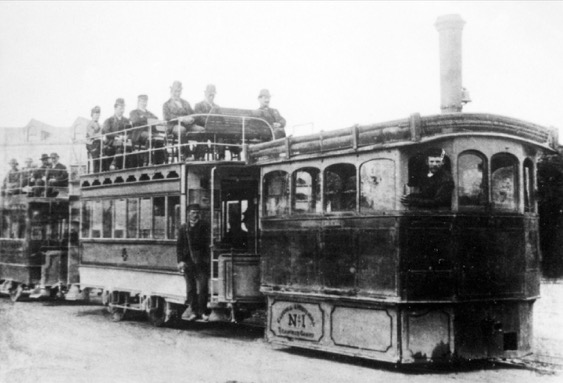
Cavehill and Whitewell Steam Tram No 1 (Kitson T49) and two trailers pictured at the Glengormley terminus — photo undated, but probably taken during trial running in May or June 1882. Photo courtesy of David Gladwin, with thanks to Trevor Preece.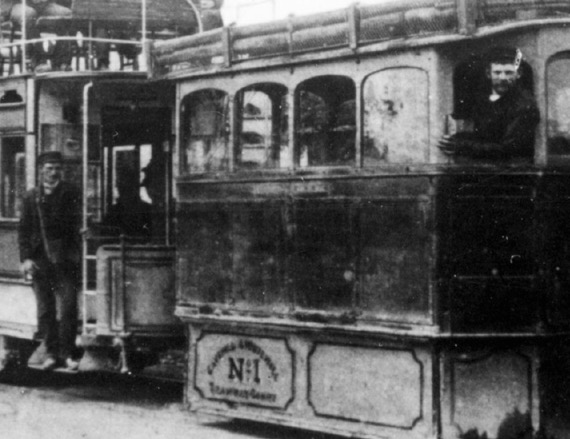
An enlargement of the above photograph showing the conductor (in informal jacket with a soft-top or kepi-style cap) and the driver (in typical railway footplate attire).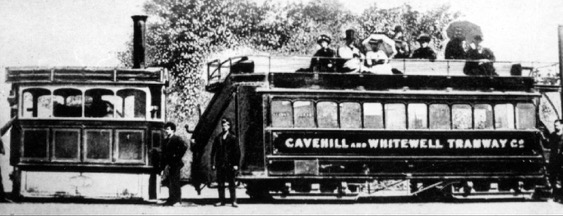
Cavehill and Whitewell Steam Tram No 1 or 2, with what is probably one of the later trailers — photo undated, but probably taken in the late 1880s. Photo courtesy of David Gladwin, with thanks to Trevor Preece.
Horse tram drivers and conductors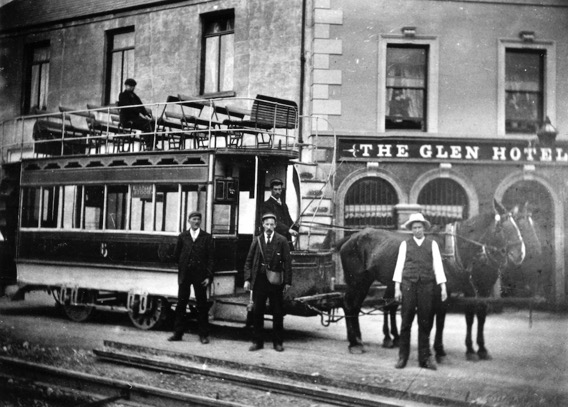
Cavehill and Whitewell Horsecar No 5 stands with crew members outside the The Glen Hotel at Glengormley — photo undated, but given the rails in the foreground, possibly taken around the time of electrification (1905), i.e., under ownership of the British Electric Traction Company. Photo courtesy of the Tramways and Light Railway Society, with thanks to David Voice.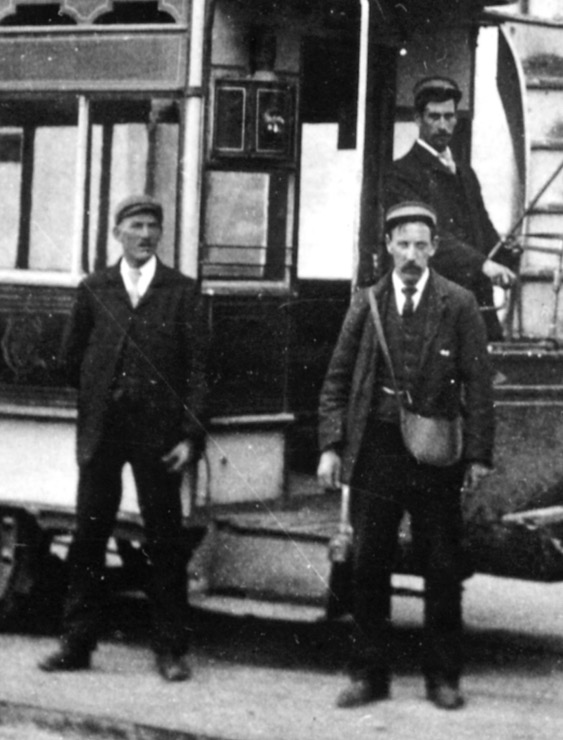
An enlargement of the above photograph showing the driver and conductor, both of whom are wearing informal jackets, but with kepi-style caps bearing a hat band of a lighter colour, presumably issued by the company.
Motormen and conductors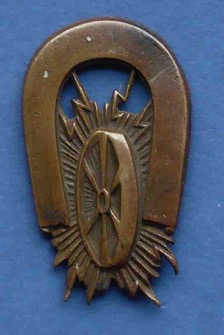
Standard British Electric Traction Company ‘Magnet & Wheel’ cap badge, as worn by employees of the Cavehill and Whitewell Tramway during the electric era, and up until the take-over by Belfast Corporation in 1911 — brass. Author's Collection.